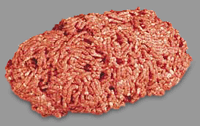but
too much interpolation
isn't good
for anyone. :-)
too much interpolation
isn't good
for anyone. :-)

Interpolation Facts:

- Creates new data based on existing data.
- The core of image manipulation processes.
- Used to boost image pixel-count.
- Works well with high-quality images.
- Over-use can destroy image quality.
A little interpolation doesn't
hurt ...
hurt ...

Interpolation is a method of creating a new pixel, whose value is determined by analyzing pixel values adjacent to the new pixel's location. Interpolation is at the core of most digital manipulation processes.
Interpolation is often used to artificially increase an image's pixel-count (sometimes called "up-sampling"). While this can be useful for output requiring a minimum pixel dimension, it does not actually increase the optical resolution. In fact, the process of interpolation actually dilutes the original information, and improper use can severely degrade image quality.
Interpolation works best on high quality images. If an image is teetering on the edge of acceptable, interpolation will likely push it to the wrong side. If the original data is barely acceptable, then artificial data (based on the original data) will do little to help.
Interpolation is a vital process, but the quality of the results depends on that of the original data. What was true in the early days of digital imaging is still true today: "garbage in... garbage out."
Interpolation is often used to artificially increase an image's pixel-count (sometimes called "up-sampling"). While this can be useful for output requiring a minimum pixel dimension, it does not actually increase the optical resolution. In fact, the process of interpolation actually dilutes the original information, and improper use can severely degrade image quality.
Interpolation works best on high quality images. If an image is teetering on the edge of acceptable, interpolation will likely push it to the wrong side. If the original data is barely acceptable, then artificial data (based on the original data) will do little to help.
Interpolation is a vital process, but the quality of the results depends on that of the original data. What was true in the early days of digital imaging is still true today: "garbage in... garbage out."